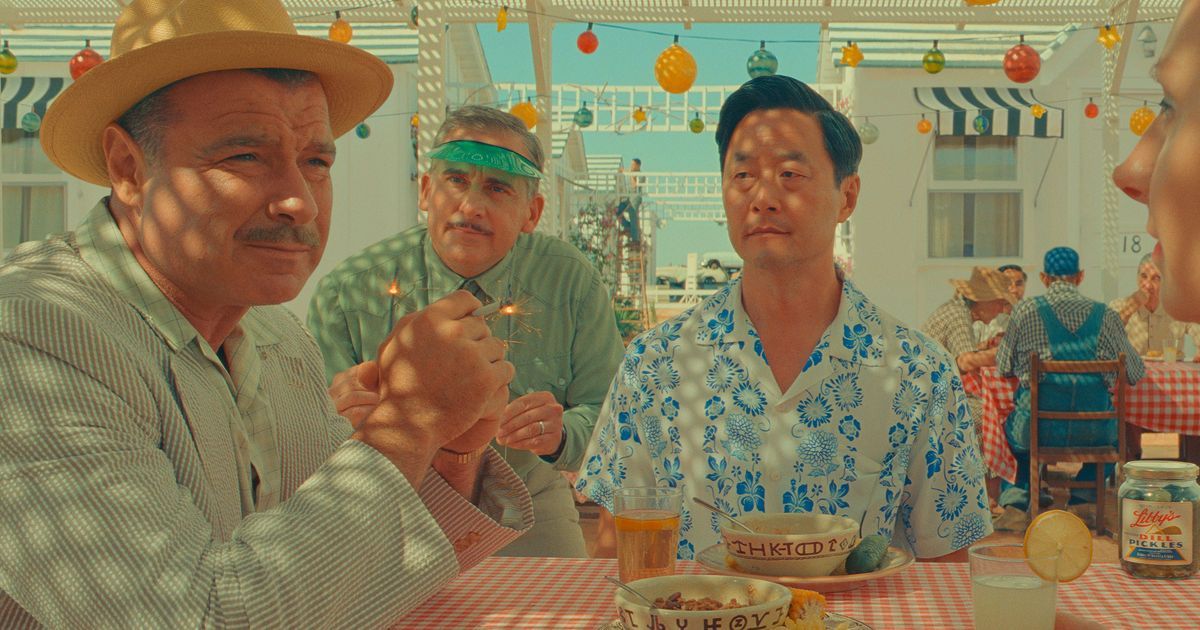Wes Anderson Has Gone Mad
His new movie, Asteroid City, brings a necessary madness to the meticulous director’s method, and it amounts to a masterpiece. Photo: Courtesy of Pop. 87 Productions/Focus Features
To the casual observer, Wes Anderson might seem like someone who either refuses to read his own press or has bought into his press to an absurd degree. Those fussy arrangements, symmetric compositions, and precise tracking shots that have become the stuff of viral videos and snarky social-media memes aren’t going away. While other filmmakers might answer their critics by branching out and shaking things up, Anderson, like Federico Fellini before him, doubles down on his stylistic peculiarities. My colleague Alison Willmore (accurately) called his last effort, The French Dispatch, “the most Wes Anderson movie Wes Anderson has ever made.” One could probably say the same for each new Anderson film and certainly for the marvelous Asteroid City, which just premiered at the Cannes Film Festival.
There’s a point to all this indulgence. Anderson’s obsessively constructed dioramas explore the very human need to organize, quantify, and control our lives in the face of the unexpected and the uncertain. The regimented universe of Moonrise Kingdom is sent into a spiraling decline by the mania of young love. The Mitteleuropaïsch candy-box milieu of The Grand Budapest Hotel is undone by the creeping evil of authoritarianism. The romantic, Continental fascinations of The French Dispatch are hit with protest, injustice, and violence. Asteroid City might be the purest expression of this dynamic because it’s about the unknown in all its forms. Death, the search for God, the creation of art, the exuberance of love, the mysteries of the cosmos — in Anderson’s telling, they’re all facets of the same thing.
Asteroid City takes place in September 1955, at a mid-century moment when everything seemed possible. Even if that spirit of optimism was belied by reality: World War II is in the rearview mirror, but its traumas persist, and the mushroom clouds in the distance suggest a potentially more menacing future ahead. Those explosions come from an atomic testing facility not too far from Asteroid City, population 83, a town that is itself the very definition of an in-between place, a collection of motel bungalows built near a 100-foot meteor crater, “halfway between Parched Gulch and Arid Plains.”
Bold curiosity is in the air, as this dead-end ghost town has been overrun by Young Stargazers and Space Cadets, a group of teens and their families who have gathered for a contest thrown by the U.S. military and the local observatory. Among the families are the Steenbecks, led by widowed war-photographer father Augie (Jason Schwartzman), who hasn’t yet told his kids that their mom died several weeks ago. (“The time is never right.”) As in so many Anderson films, the kids are precocious introverts, while the adults are comically haunted. As Augie’s teenage brainiac son, Woodrow (Jake Ryan), starts to fall for Dinah (Grace Edwards), a 15-year-old botany wizard, Augie falls for her mother, Hollywood actress Midge Campbell (Scarlett Johansson). Flaunting a black eye for research purposes, the actress warns the war photographer in advance that she plays “tragic, abused alcoholics” and that she’ll probably one day be discovered dead in a bathtub surrounded by pills.
Anderson’s films have become more diffuse over the years with an ever-expanding dramatis personae, a particularly apt term in this case since we’re told that what we’re watching is really a theater piece written by the legendary American playwright Conrad Earp (Edward Norton). The film actually begins on a black-and-white television stage with the story narrated by a Rod Serling–like Host, played by Bryan Cranston. (So, really, it’s a play within a play within a TV production within a movie.) The Host reminds us that “Asteroid City does not exist. It is an imaginary drama created expressly for the purposes of this broadcast. The characters are fictional, the text hypothetical, the events an apocryphal fabrication.” In other words, the story itself is a phantom, unknowable.
At various points, Anderson cuts back to the “actors” playing several of the aforementioned parts. Not unlike the people they’re portraying, they too wrestle with their own fears of the unknown. They are also in 1955, at a moment when the work of the Actors Studio was transforming Hollywood and craft and discipline were taking a back seat to the animating secrets of the soul. The neurotic, fresh-faced Jones Hall (also played by Schwartzman, naturally) struggles with how to accurately depict Augie’s grief. But in his lostness, we learn, lies the actor’s genius.
The audacity and beauty of Asteroid City lie in the way it connects the mysteries of the human heart to the secrets of science and the universe. When the visitors to Asteroid City encounter an actual alien, it sends their world into a tailspin, both altering their very notions of reality and driving them even further into their prior assumptions. (In the face of the unknown, it turns out, we cling even more to our identities.) The visitation also disrupts Anderson’s ornate cinematic world, as the movie becomes faster, stranger, funnier, warmer — almost as if the filmmaker himself were rummaging through his material, desperately searching for an explanation to the mysteries he’s unearthed.
Late in the movie, Jones steps away from playing Augie and runs into the actress (Margot Robbie) who was to play the part of his wife but was reportedly cut from the finished piece. As the two recall the scene they would have had together, the Andersonian whimsy slips away to reveal a perfect moment: two people communing with the messiness of life through their memory of a scene that doesn’t exist, from a play that never happened, presented within a theatrical-cinematic fiction pretending to be a TV show. I cried like a baby. There has always been a method to Wes Anderson’s madness, but Asteroid City reminds you that there is also a madness to his method. And that, ultimately, is what makes him a great artist.
Source: Vulture


